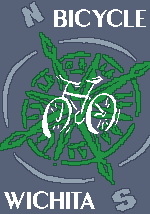Today, Biking Across Kansas comes to our corner of the Plains--the riders spent the evening in Halstead (on U.S. 50 just west of Newton), and today they will pass through Sedgwick, Furley, Towanda, and El Dorado on the way to tonight's stop at Eureka (here is the Google Map of the route). For further information, including daily updates, visit the Biking Across Kansas website.
And tomorrow (the 11th), that one-day wonkfest of local transportation planning, WAMPOpalooza: from 1-2:30 in City Council chambers, WAMPO will be hosting a Complete Streets webinar; then from 4:30-6 at the Water Center, 101 E. Pawnee (that's Herman Hill Park, by the way), WAMPO will have an open house to discuss the status of the 2010 Transportation Improvement Program (TIP) (a brief description is here).
For those of you interested in gaining some sense of how local planning fits into a national context (read: if you'd like something like an opening act to heighten your anticipation for tomorrow), Streetsblog now has a new page called Streetsblog Capitol Hill, which follows debates, recommendations, and the progress of mass/alternate transportation legislation through Congress. The page went live only yesterday, but it already bears the good news the House Appropriations Committee has just approved $68.8 billion for the upcoming fiscal year for the departments of Transportation and Housing & Urban Development--a 25% increase over last year. That money, by the way, is in addition to the money to be allocated in the six-year transportation bill presently working its way through Congress. Translation: assuming the economy doesn't utterly collapse and/or the State of Kansas and the City of Wichita have their respective planning ducks in a row, lots of money will be available to do some very good things.
Here's why our participation in these discussions matters: No matter our respective politics, both liberals and conservatives should be able to support mass/alternate transportation projects because of their cost-effectiveness. Yet another message of the picture you see at this post is that a street designed to accommodate pedestrians, bikers and buses as well as cars actually maximizes that street's traffic capacity: more people can use the same space than if it were designed strictly for automobiles--and, in the case of re-striping projects such as some of those proposed by WAMPO, these things are dirt-cheap when compared to widening projects. Public transportation and bike-lanes and bike paths look like luxuries only when people don't use them. But a time is coming, and sooner than we think, when these projects will become more and more necessary if we want to have transportation infrastructure at all.
Subscribe to:
Post Comments (Atom)















No comments:
Post a Comment